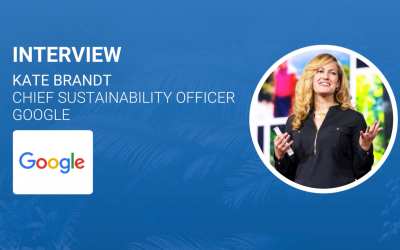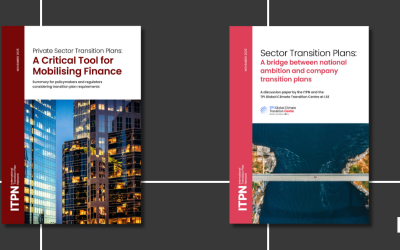Gill Lofts on what we can expect from financial services over the next 12 months
Climate Action caught up with Gill Lofts, EY Global Sustainable Finance Leader, on what we can expect from financial services over the next 12 months.

Climate Action caught up with Gill Lofts, EY Global Sustainable Finance Leader, on what we can expect from financial services over the next 12 months.
At COP28, historic commitments were made to transition away from fossil fuels in energy systems. What does this mean for transition finance?
In order to transition the global economy to a low carbon, sustainable future, global clean energy investments of approximately US$4-5 trillion are required annually by 2030 – a more than threefold increase from existing investment levels. Emerging and developing countries will require in excess of US$2.4 trillion of this annual investment. All indicators suggest there is sufficient global capital and liquidity to close financing gaps, but the existing mechanisms, standards and momentum are not yet ready to deliver financing at the scale and speed needed. The key question that global leaders and financial intuitions are asking is: how can we mobilise more finance, more quickly, and ensure a real-world impact of that financing in a timeframe that limits the effects of global warming?
The commitments made at COP28 mark one of the most significant moments in accelerating the transition of the global economy to a low carbon future. Private finance has a key role in closing this gap, with estimates suggesting that private finance for climate action can leverage public sector financing up to tenfold. To do this the private sector needs the commitments and enabling policy from government. The scale of commitments at COP28, to transition away from fossil fuels by early 2025, were received positively and seen as a vote of confidence to business and investors seeking to mobilise transition finance – including investment into green technology. The importance of this type of market signal to enable the transition was highlighted by the International Energy Agency (IEA), who stated that the “single largest driver” for emissions reductions would be tripling global renewable capacity.
Mobilising transition finance will also require global coordination and effort if we are going to ensure a just transition. There is a notable difference already in the pace of change between the global north and south, with the global north attracting a disproportionate amount of investment. To ensure a just transition, more funds will need to be directed towards the global south. An example of recent, positive progress is the UK’s commitment of £140 million to help developing countries switch to cleaner energy and progress towards net zero.
How can we harness and strengthen public and private sector collaboration? What are the challenges in our way?
In the past few years we have definitely seen a positive increase in public and private sector collaboration on transition finance. Key to strengthening this is aligning interest and understanding. Financial services institutions are primarily focused on commercial risk and opportunity, so a key lever for public sector bodies will be identification and alignment on opportunities that are commercially viable from a private sector perspective.
Historically, the level of complexity and variation in frameworks, mechanisms, and standards have made collaboration complex, reducing its efficiency and effectiveness. To overcome these challenges, focused reforms are needed to streamline systems – we’ve seen positive changes in this direction with the International Sustainability Standards Board (ISSB) and Corporate Sustainability Reporting Directive (CSRD) supporting harmonized reporting. Collaborative initiatives such as the Glasgow Financial Alliance for Net Zero (GFANZ) – now comprising over 675 financial services institutions - or the new Global Climate Finance Centre in Abu Dhabi, also play a significant role in helping to identify and overcome the key barriers to investment in transition and low-carbon projects. Blended finance (the strategic use of public sources of capital to attract private investment) presents a growing opportunity to mobilise climate finance at scale and pace and could be a strategically transformative theme for investment in low carbon economies.
If we accept that VCM play a valuable role in transition, how do you scale them?
To scale Voluntary Carbon Markets (VCMs), it's essential first to enhance their integrity, quality, and certainty. Given that VCMs are a relatively immature ecosystem, bolstering these factors will significantly improve buyer confidence, promoting larger and more frequent investments. This process can entail stricter verification processes, rigorous project evaluation, and ongoing monitoring and reporting.
The absence of universal standards in the VCM significantly hampers the ease of ownership and investment, thus impacting the scalability of the market. The sector currently faces issues with heterogeneity in carbon credit types, varied calculations methodologies, and differentiating high-quality credits from others. However, COP28 saw global recognition from governments about the importance of building integrity in VCMs, so we expect progress in this market, to bring greater confidence to market participants.
As a result, the creation of market standards, indices, and more streamlined methods to purchase carbon credits will aid in scaling VCMs. These measures should provide greater certainty and clarity to investors and owners, by ensuring consistent quality and comparability of carbon credits. A more structured market will instil confidence, attract investments, and ultimately, enable VCMs to play a more impactful role in the global transition towards sustainability.
What are some key trends you’re seeing in regulations and frameworks to report on climate-related activity and impacts?
Global standards and reporting frameworks are essential to truly tackle climate change, and should be viewed as an opportunity to accelerate action, giving organisations freedom from ambiguity and the opportunity to go further, faster.
Regulation on climate-related disclosure is now the norm across the G20, with more than half of G20 members having policies in place. We are also seeing an increase in the recognition of the critical importance of frameworks and disclosures related to nature and biodiversity impacts. Nearly one third of early adopters of the Taskforce on Nature-related Financial Disclosures (TNFD), were financial services institutions, including some of the world’s largest asset owners and managers, representing US$4tn in asset under management as well as banks, insurers and other leading market actors.
However, despite the positive overall direction, there are persistent challenges with turning commitments into tangible action – our fifth EY Climate Risk Barometer highlighted that many organizations are still struggling to translate disclosures into concrete actions:
- Nearly half (47%) of companies assessed, did not have a coherent transition plan on climate risk
- Just 26% of companies are including the quantitative impacts of climate-related risks in their financial statements
To drive sustainable change, financial services institutions will need to consider interim and long-term targets to ensure that targets are met, as well as ensuring the confidence of stakeholders.
How can financial services institutions ensure that they recruit and retain people with the right skills and experience to deliver on this sustainability agenda?
We’re definitely seeing sustainability as a key decision factor in recruitment and retention –millennials are 3 times more likely to seek employment with a company because of its stance on social and/or environmental issues. For financial services institutions this means being clear on their sustainability ambition and strategy, and demonstrating transparency in their sustainability-related operations and commitments. According to the Global Green Skills Report, in 2023, while the median green talent concentration across all industries is 12.3% (meaning that one in eight workers have green skills), it’s only 6.8% for financial services professionals. This green skills gap heightens the need for financial services institutions to consider these issues, alongside investing in upskilling and reskilling their workforce to attract and retain talent committed to driving their sustainability agenda.
The slowing pace of progress on sustainability also presents a risk when considering talent development and retention. Our EY Sustainable Value Study, published in Nov 2023, surveyed 520 Chief Sustainability Officers (CSO), across global companies, showed that 4 in 10 CSOs may leave their job in the next year, driven by the slow pace of progress. However, we found that ‘transformational CSOs’ — those with the most resources and influence within their organization — are making more progress and are less likely to leave the organisation. These CSOs have made bigger commitments and more progress to date, with better collaboration across the C-suite and higher job satisfaction. From this, we can see that by being strategic in supporting sustainability leaders to leverage their influence and resources to drive transformational change, financial services institutions can have a competitive advantage in both impact and talent retention at all levels of their business.
The views reflected in this article are the views of the author and do not necessarily reflect the views of the global EY organization or its member firms.





